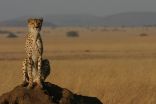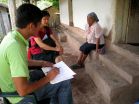(Press-News.org) NEW YORK (May 6, 2015) -- To fence or not to fence? That is the question facing conservationists concerned with barriers that keep wildlife in and people out.
According to a new study by the Zoological Society of London (ZSL), Wildlife Conservation Society (WCS) and other groups, appearing in April 20 edition of the Journal of Applied Ecology, new policies must be developed before fences are erected - particularly in dryland ecosystems where mobility is essential for both humans and wildlife.
Some nations are considering fences as a means to protect remnant wildlife populations. For example, Uganda intends to fence all of its national parks to stem human-wildlife conflicts, while Rwanda recently erected a 120 km fence around Akagera National Park.
But the study's authors caution that evidence is limited showing that fences are effective management tools, particularly in drylands.
"Large-scale fencing can disrupt migration pathways and reduce access to key areas within drylands, such as seasonal foraging areas," said lead author Sarah Durant of ZSL. "This can lead to severe reductions in migratory wildlife populations and may prompt wider impacts on non-migratory species."
The study says that policies are needed to evaluate whether fences should be erected and should be evaluated based on wildlife movement and distribution, climate change predictions, costs and benefits to local people, and other factors.
Said co-author James Deutsch of WCS: "Fencing can initially appear to be an easy conservation solution. Yet, unless fencing strategies have local community support and financing for maintenance, there is a danger that they may generate more problems than they solve."
The authors suggest that The United Nations Conventions on Migratory Species (CMS) and to Combat Desertification (UNCCD) are appropriate international agreements for leading to the development of policies and guidelines on fencing drylands.
In response, the Scientific Council of CMS has proposed to form a Working Group on fencing problems and policies in dryland ecosystems.
Said co-author Roseline Beudels-Jamar from the CMS Scientific Council: "CMS is concerned about the impact of human-wildlife conflict on both wildlife and on vulnerable livelihoods of marginalised people, and would like to better understand the impacts of fencing, or alternative methods, if used to mitigate such conflicts."
INFORMATION:
Wildlife Conservation Society (WCS)
MISSION: WCS saves wildlife and wild places worldwide through science, conservation action, education, and inspiring people to value nature. VISION: WCS envisions a world where wildlife thrives in healthy lands and seas, valued by societies that embrace and benefit from the diversity and integrity of life on earth. To achieve our mission, WCS, based at the Bronx Zoo, harnesses the power of its Global Conservation Program in nearly 60 nations and in all the world's oceans and its five wildlife parks in New York City, visited by 4 million people annually. WCS combines its expertise in the field, zoos, and aquarium to achieve its conservation mission. Visit: http://www.wcs.org; Facebook; Youtube Follow: @thewcs.
ZSL
Founded in 1826, the Zoological Society of London (ZSL) is an international scientific, conservation and educational charity whose mission is to promote and achieve the worldwide conservation of animals and their habitats. Our mission is realised through our ground-breaking science, our active conservation projects in more than 50 countries and our two Zoos, ZSL London Zoo and ZSL Whipsnade Zoo. For more information visit http://www.zsl.org
This news release is available in German.
An X-ray study carried out at DESY allows to improve the quality of chocolate. The study offers new insights into the formation of fat bloom, an unwelcome white layer that occasionally forms on chocolate. "Although fat blooming is perfectly harmless, it causes millions in damage to the food industry as a result of rejects and customer complaints," explains the main author of the study, Svenja Reinke, from the Hamburg University of Technology (TUHH). "Despite this well known quality issue, comparatively little has been known ...
(BOSTON) - Increasingly, scientists across the world and in the Unites States are reporting new and groundbreaking innovations in biotechnology with transformative implications in human health and environmental sustainability. Examples range from synthetically created, metabolically-engineered bacteria for the sustainable production of fuel to gene editing therapies that could one day help in the prevention and treatment of a large number of human diseases.
While these technologies are developed in laboratories, researchers are not only giving utmost consideration to ...
New Haven, Conn. - Convincing a large group of people to change its behavior is no popularity contest, a new study shows.
In a novel experiment, researchers found that certain public health interventions work best when key "influencers" in a face-to-face social network are exposed to the program. What's surprising, they say, is that those key influencers are not the most socially connected people in the network.
Furthermore, those individuals can be identified through a survey method informed by network structure rather than costly and time-consuming social network mapping. ...
Maybe it's not such a dog-eat-dog world after all. A clever combination of two different types of computer simulations enabled a group of Illinois researchers to uncover an unexpectedly cooperative group dynamic: the spontaneous emergence of resource sharing among individuals in a community. Who were the members of this friendly, digitally represented collective? Escherichia coli, rod-shaped bacteria found in the digestive systems of humans and many other animals.
The finding, initially predicted by mathematical models and then confirmed through empirical testing, was ...
Chocolate is one of the world's most popular foods, but when a whitish coating called a bloom appears on the confection's surface, it can make consumers think twice about eating it. The coating is made up of fats and is edible, but it changes the chocolate's appearance and texture -- and not for the better. Now scientists report in the journal ACS Applied Materials & Interfaces new information that could help chocolatiers prevent blooms from forming.
Svenja K. Reinke and colleagues explain that baked goods and confectionery products, including chocolate, contain a mix ...
WASHINGTON, DC (May 6, 2015) -- Patients with a history of trauma can benefit from working with healthcare providers who understand trauma's role in health and can offer resources to assist with healing. A commentary published today in the journal Women's Health Issues proposes an approach to providing such trauma-informed primary care (TIPC). Edward L. Machtinger, MD, director of the Women's HIV Program (WHP) at the University of California, San Francisco, and his co-authors identify four core components of a TIPC approach: environment, screening, response, and a robust ...
Diagnosing a heart attack can require multiple tests using expensive equipment. But not everyone has access to such techniques, especially in remote or low-income areas. Now scientists have developed a simple, thermometer-like device that could help doctors diagnose heart attacks with minimal materials and cost. The report on their approach appears in the ACS journal Analytical Chemistry.
Sangmin Jeon and colleagues note that one way to tell whether someone has had a heart attack involves measuring the level of a protein called troponin in the person's blood. The protein's ...
Conventional silicon-based computing, which has advanced by leaps and bounds in recent decades, is pushing against its practical limits. DNA computing could help take the digital era to the next level. Scientists are now reporting progress toward that goal with the development of a novel DNA-based GPS. They describe their advance in ACS' The Journal of Physical Chemistry B.
Jian-Jun Shu and colleagues note that Moore's law, which marked its 50th anniversary in April, posited that the number of transistors on a computer chip would double every year. This doubling has ...
COLUMBUS, Ohio - A new study has identified a regulatory pathway in natural killer cells that inhibits their maturation and homing behavior. Natural killer cells are one of the body's first lines of defense against viruses and cancer. The findings could lead to new strategies for boosting natural-killer cell activity against cancer and viral infections.
The study was led by researchers at The Ohio State University Comprehensive Cancer Center - Arthur G. James Cancer Hospital and Richard J. Solove Research Institute (OSUCCC - James). It showed that a protein called Foxo1 ...
WASHINGTON, DC, May 6, 2015 -- Some 9 million American families lost their homes to foreclosure during the late 2000s housing bust, driving many to economic ruin and in search of new residences. Hardest hit were black, Latino, and racially integrated neighborhoods, according to a new Cornell University analysis of the crisis.
Led by demographer Matthew Hall, researchers estimate racial segregation grew between Latinos and whites by nearly 50 percent and between blacks and whites by about 20 percent as whites abandoned and minorities moved into areas most heavily distressed ...


